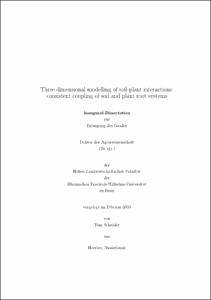Three dimensional modelling of soil-plant interactions: consistent coupling of soil and plant root systems

Three dimensional modelling of soil-plant interactions: consistent coupling of soil and plant root systems

| dc.contributor.advisor | Vereecken, Harry | |
| dc.contributor.author | Schröder, Tom | |
| dc.date.accessioned | 2020-04-13T16:38:47Z | |
| dc.date.available | 2020-04-13T16:38:47Z | |
| dc.date.issued | 10.07.2009 | |
| dc.identifier.uri | https://hdl.handle.net/20.500.11811/3950 | |
| dc.description.abstract | To understand how the uptake of water by roots locally affects and is affected by the soil water distribution, 3D soil-root water transfer models are needed. Nowadays, fully coupled 3D models at the plant scale, that simulate water flow along water potential gradients in the soil-root continuum, are available. However, the coupling of the soil and root system is not investigated thoroughly. In the available models the soil water potential gradient below the soil spatial discretization is neglected. Because of the non-linear behavior of the soil hydraulic conductivity, large discrepancies are expected in estimation of the soil water potential at the soil-root interface, if these local soil-root interactions are considered. This will affect the estimation of root water potentials and as such the amount of water taken up by the roots of plants. In this thesis a microscopic analytical approach is developed that describes the soil hydraulic conductivity drop below the soil spatial discretization. The local hydraulic conductivity drop is derived and validated for a 3D soil-root water transfer model from the bulk soil to the soil-root interface. Furthermore, it was incorporated in the 3D model for the assessment of densed root architectures. Simulations showed that the total root water uptake is affected strongly by considering the local soil hydraulic conductivity drop around roots. Especially under conditions when the radial root hydraulic conductivity, regulating root water uptake, is larger than the soil hydraulic conductivity, regulating water flow in the soil. It was furthermore shown that a fine soil and root discretization was required to accurately predict soil and root water potentials. The usage of a fine soil and root discretization goes along with a considerable computational effort. Therefore a grid refinement technique was developed, based on the root architecture. Simulations performed with this refinement technique showed that the computational time was reduced largely, compared to very fine regular grids, but with maintained accuracy. | en |
| dc.description.abstract | Dreidimensionale Modellierung von Boden-Pflanzen-Wechselwirkungen: Kopplung von Boden- und Wurzelsystemen Um zu verstehen, wie die Wasseraufnahme durch Wurzeln lokal die Wasserverteilung im Boden beeinflusst und durch diese beeinflusst wird, werden 3D-Boden-Wurzel-Wassertransfer-Modelle benötigt. Es wurden bereits vollständig gekoppelte 3D Modelle auf der Pflanzenskala entwickelt, die den Wasserfluss entlang von Wasserpotential-Gradienten innerhalb des Boden-Wurzel-Kontinuums simulieren. Die Kopplung des Boden-Wurzelsystems ist jedoch noch nicht gründlich untersucht worden. In den vorhandenen Modellen wird der Boden-Wasserpotential-Gradient unterhalb der räumlichen Auflösung des Bodens vernachlässigt. Aufgrund des nicht-linearen Verhaltens der hydraulischen Leitfähigkeit des Bodens sind sehr starke Abweichungen in der Schätzung des Boden-Wasserpotentials an der Boden-Wurzel-Grenzschicht zu erwarten, wenn diese lokalen Boden-Wurzel-Wechselwirkungen berücksichtigt werden. Dies wirkt sich auf die Schätzung des Wurzel-Wasserpotentials aus und somit auf die Wassermenge, die durch die Pflanzenwurzeln aufgenommen wird. In dieser Arbeit wurde ein mikroskopischer analytischer Ansatz zur Beschreibung der hydraulischen Leitfähigkeitsgradienten unterhalb der räumlichen Diskretisierung des Bodens entwickelt. Der lokale Leitfähigkeitsgradient wurde für ein 3D Boden-Wurzel-Wasser- transfer-Modell vom Boden zur Boden-Wurzel-Grenzschicht hergeleitet und validiert, und in ein 3D Modell zur Untersuchung von dichten Wurzelarchitekturen integriert. Anhand von Simulationen wurde gezeigt, dass die gesamte Wurzelwasseraufnahme durch die Berücksichtigung der lokalen hydraulischen Leitfähigkeitsgradienten in der näheren Wurzelumgebung stark beeinflusst wird. Dieser Einfluss war besonders stark, wenn die radiale Wurzelleitfähigkeit, die die Wurzelwasseraufnahme reguliert, größer war als die hydraulische Leitfähigkeit des Bodens, die den Wasserfluss im Boden kontrolliert. Gleichzeitig wurde gezeigt, dass eine feine Boden- und Wuzeldiskretisierung notwendig ist, um Wasserpotentiale im Boden und in den Wurzeln exakt zu beschreiben. Die Verwendung von feinen Boden- und Wurzeldiskretisierungen ist mit einem beträchtlichen Rechenaufwand verbunden. Daher wurde eine Methode zur Gitterverfeinerung entwickelt, die auf der Wurzelarchitektur basiert. Simulationen zeigten, dass die Rechenzeit durch diese Verfeinerungsmethode stark verkürzt wurde im Gegensatz zu sehr feinen regulären Gittern. Die Genauigkeit blieb dabei unverändert. | en |
| dc.language.iso | eng | |
| dc.relation.ispartofseries | Schriften des Forschungszentrums Jülich. IAS Series ; 1 | |
| dc.rights | In Copyright | |
| dc.rights.uri | http://rightsstatements.org/vocab/InC/1.0/ | |
| dc.subject | Boden-Wurzel-Wechselwirkungen | |
| dc.subject | mikroskopischer Wasserfluss | |
| dc.subject | Boden-Pflanzen-Wechselwirkungen | |
| dc.subject | Soil-root interactions | |
| dc.subject | microscopic water flow | |
| dc.subject | soil-plant interactions | |
| dc.subject.ddc | 630 Landwirtschaft, Veterinärmedizin | |
| dc.title | Three dimensional modelling of soil-plant interactions: consistent coupling of soil and plant root systems | |
| dc.type | Dissertation oder Habilitation | |
| dc.publisher.name | Universitäts- und Landesbibliothek Bonn | |
| dc.publisher.location | Bonn | |
| dc.rights.accessRights | openAccess | |
| dc.identifier.urn | https://nbn-resolving.org/urn:nbn:de:hbz:5N-18008 | |
| ulbbn.pubtype | Erstveröffentlichung | |
| ulbbnediss.affiliation.name | Rheinische Friedrich-Wilhelms-Universität Bonn | |
| ulbbnediss.affiliation.location | Bonn | |
| ulbbnediss.thesis.level | Dissertation | |
| ulbbnediss.dissID | 1800 | |
| ulbbnediss.date.accepted | 05.06.2009 | |
| ulbbnediss.institute | Institut für Chemie und Dynamik der Geosphäre / Agrosphäre (ICG-4), Forschungszentrum Jülich GmbH | |
| ulbbnediss.fakultaet | Landwirtschaftliche Fakultät | |
| dc.contributor.coReferee | Goldbach, Heiner E. |
Dateien zu dieser Ressource
Das Dokument erscheint in:
-
E-Dissertationen (1098)




